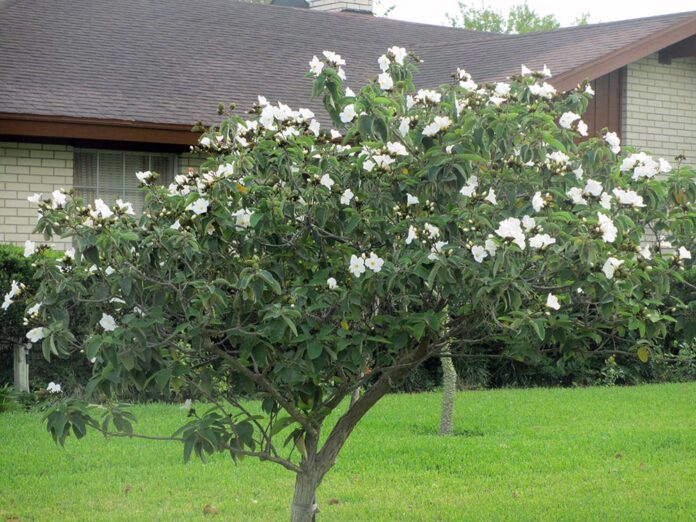By, Lori Murray, Cameron County Master Gardener, Texas Superstar Specialist
From time to time, you may have noticed some small to medium-sized trees covered with white flowers around your neighborhood and in commercial landscapes. These beauties are commonly known as wild olive trees, a native to the Rio Grande Valley also known as the Mexican Olive, Texas Wild Olive, and the Anacahuita.
The wild olive will typically flower at heights of 6 – 10 feet although it can occasionally reach heights of 25 feet, and, while you are probably aware that horticulturists are preaching the use of native plants in your landscape, your problem with following that advice is that you want flowers. The wild olive will keep all of us happy because it has the benefits of native plants but also produces beautiful flowers over much of the year. A single wild olive in a small condo backyard can provide beauty and interest almost immediately.
The tree is heat tolerant and will withstand exposure to full sun even during our Valley summers. It is considered an evergreen although it will briefly lose its leaves after severe cold weather. Fortunately, when the weather warms, the tree will put out new leaves. It has low water requirements although an occasional deep watering into well-drained soil will do wonders. It will tolerate most of the soils in the Valley area. The wild olive in our front yard is in our typical “gumbo” soil and I have seen thriving trees along the highway in the Starr County “sands.”
You should always have a plan in mind when you are in the process of planting a tree. Your plan should take into consideration the expected growth of the tree you are planting as well as the expected growth of other trees and shrubs near it. In cruising the neighborhood seeking photo opportunities to accompany this article, I found a number of beautiful olive trees that were too closely mixed in with other trees and shrubs in the yard.
This beautifully shaped tree is best seen as a stand-alone part of your landscape. Its natural shape, with minor pruning, is almost bonsai-like. My favorite location for the tree is standing alone in the vicinity of the street where those driving by can see and be jealous of my green thumb!
Many experts suggest that this tree is not best located in beds where any droppings might germinate. It is definitely not appropriate near the pool, and you may want to avoid patios and sidewalks as the olives have an oily consistency and will stain where they drop. Wild olive trees can be purchased in most local and native plant nurseries, but not big box stores. If you are a little more adventurous and want to try to grow them from scratch, check the websites below for more detailed instructions and some very good pruning tips as well.
ADDITIONAL INFORMATION
http://aggie-horticulture.tamu.edu/ornamentals/natives/cordiaboissieri.htm
http://www.billbritt.info/gardening/trees/wild_olive_tree.html




